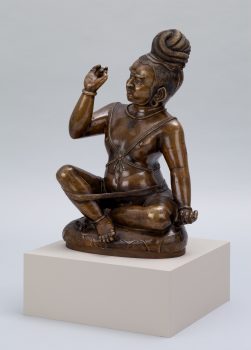Central Tibet
16th century



Central Tibet
16th century



Kanha, “The Black One,” one of the most popular of the eighty-four Indian great Tantric adepts (mahasiddha), lived in India around the seventh or eighth century. He was originally a Hindu yogi, but after becoming the primary disciple of the mahasiddha Virupa, Kanha entered a lineage that eventually became foundational to the Sakya tradition, one of the four main schools of Tibetan Buddhism.His brow furrowed in an intense expression of concentration, he bears the characteristics of an accomplished ascetic. He sits in a yogic pose on an antelope hide draped over a patterned cushion, his right leg supported by a strap. His long matted hair is piled on top of his head in a massive coil and bone ornaments cross his chest. This solid, impressive sculpture once belonged to a set of the Path and Result (Lam ‘bras) lineage portraits of the teachers in the Sakya School lineage.
A religious movement that originated in India around the fifth to seventh century with sacred writings and esoteric teachings and practices transmitted from teacher to student through initiation. These remain an important part of Hinduism and Buddhism today.
The transmission of teachings from one generation to the next, from teacher to student, traced all the way back to the Buddha without interruption. A complete lineage is essential in Tantric Buddhist practices as it makes the blessings of the teaching more powerful.
Himalayan art includes portraits of legendary and historical humans, including accomplished religious teachers (lamas), the Buddha’s original disciples (arhats), and spiritually accomplished tantric masters (mahasiddhas).
Today, Tibetans primarily inhabit the Tibetan Plateau, situated between the Himalayan mountain range and the Indian subcontinent to the west, Chinese cultural regions to the east, and Mongolian cultural regions to the northeast. During the 7th to 9th century, Tibetan rulers expanded their empire across Central Asia, and established Buddhism as the state religion.
Get the latest news and stories from the Rubin, plus occasional information on how to support our work.